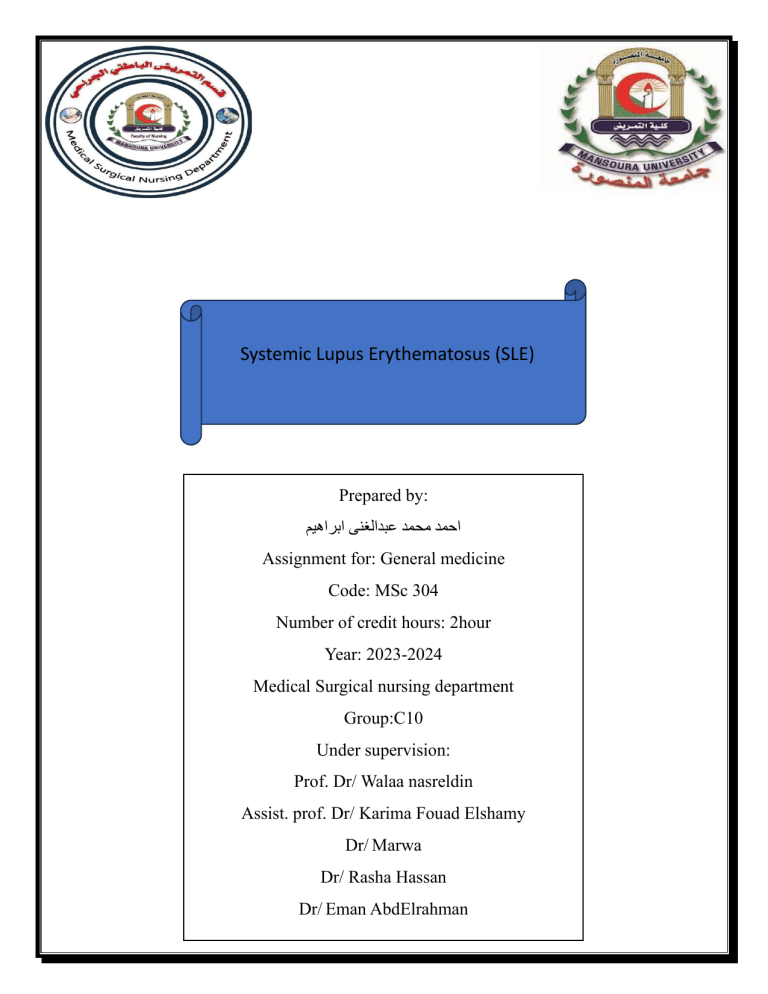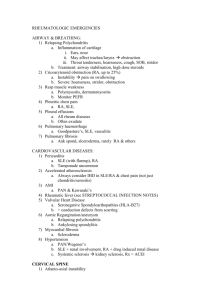
Systemic Lupus Erythematosus (SLE) Prepared by: احمد محمد عبدالغنى ابراهيم Assignment for: General medicine Code: MSc 304 Number of credit hours: 2hour Year: 2023-2024 Medical Surgical nursing department Group:C10 Under supervision: Prof. Dr/ Walaa nasreldin Assist. prof. Dr/ Karima Fouad Elshamy Dr/ Marwa Dr/ Rasha Hassan Dr/ Eman AbdElrahman The anatomy and physiology of the immune system with systemic lupus erythematosus (SLE): Anatomy of the Immune System: • The immune system is a complex network of cells, tissues, and organs that work together to protect the body from infection and disease. It is divided into two main parts: • Innate immune system: This is the first line of defense against infection and is present at birth. • Adaptive immune system: This is the second line of defense and is developed overtime. • The immune system is made up of a variety of cells, including: White blood cells, Macrophages, Dendritic cells, B cells, T cells. • The immune system also includes a variety of organs and tissues, including: Lymph nodes, Spleen, Thymus, Bone marrow. Physiology of the Immune System: • The immune system works by recognizing and responding to antigens. Antigens are substances that are foreign to the body and can trigger an immune response. When an antigen enters the body, it is taken up by antigen-presenting cells, such as dendritic cells. These cells then present the antigen to lymphocytes, which are the main cells of the adaptive immune system. • B cells and T cells work together to respond to antigens. B cells produce antibodies, which are proteins that recognize and bind to specific antigens. Antibodies can neutralize viruses and bacteria, and they can also mark pathogens for destruction by macrophages. T cells help to activate B cells and macrophages. They can also kill infected cells directly. • The immune system is a complex system that is constantly working to protect the body from infection and disease. It is important to maintain a healthy immune system by eating a healthy diet, getting enough sleep, and managing stress. Introduction: SLE is a chronic autoimmune disease that affects the immune system. In SLE, the immune system mistakenly attacks the body's own tissues, causing inflammation and damage. The exact cause of SLE is unknown, but it is thought to be caused by a combination of genetic, environmental, and hormonal factors. SLE can affect many different parts of the body, including the skin, joints, kidneys, brain, and heart. Symptoms of SLE can vary from person to person and can range from mild to severe. Definition: Systemic lupus erythematosus (SLE) It is a systemic connective tissue disorder. SLE is caused by the immune system attacking healthy tissues and cells in the body. -This can lead to a wide range of symptoms, from mild to severe. Causes: The exact cause of SLE is unknown, but it is believed to be a combination of genetic and environmental factors. 1– Genetic factors: -People with a family history of SLE are more likely to develop the disease. Certain genes have been associated with an increased risk of SLE, including: ● HLA-DR2 and HLA-DR3 ● IRF5 ● STAT4 -These genes are involved in the immune system, and it is thought that they may make people more susceptible to developing SLE. 2– Environmental factors: -Several environmental factors have been linked to an increased risk of SLE, including: ● Exposure to ultraviolet (UV) light: UV light can trigger SLE flare-ups in people who already have the disease. ● Infections: Some infections, such as Epstein-Barr virus (EBV), have been associated with an increased risk of SLE. ● Certain medications: Some medications, such as hydralazine and procainamide, can trigger SLE in some people. ● Silica dust exposure: Exposure to silica dust, such as from sandblasting or grinding, has been linked to an increased risk of SLE. ● Stress: Stress can trigger SLE flare-ups in people who already have the disease. 3– Hormonal factors: SLE is more common in women than in men= (9:1). This suggests that hormones, such estrogen, may play a role in the development of the disease. Predisposing factors: -In addition to genetic and environmental factors, there are certain factors that may make someone more likely to develop SLE. These include: ● Age: SLE is most often diagnosed between the ages of 15 and 44. ● Race and ethnicity: SLE is more common in African Americans, Hispanics, and Asian Americans than in whites. ● Family history: People with a family history of SLE are more likely to develop the disease. Manifestation of SLE: -The most common symptoms of SLE include: ➢ 1– Musculoskeletal: ● Arthritis and arthralgia (joint pain and inflammation). ● Myositis (muscle inflammation). ● Tendonitis (inflammation of the tendons). ➢ 2– Skin: ● Malar rash (a butterfly-shaped rash across the cheeks and nose). ● Discoid lupus (a scaly, red rash that usually appears on the face, scalp, or ears). ● Photosensitivity (skin rash or blistering after exposure to sunlight). ● Alopecia (hair loss). ➢ 3– Constitutional: ● Fatigue. ● Fever. ● Weight loss. ➢ 4– Neurologic: ● Headaches. ● Seizures. ● Cognitive dysfunction. ➢ 5– Cardiopulmonary: ● Pleuritis (inflammation of the lining of the lungs). ● Pericarditis (inflammation of the lining around the heart). ● Pulmonary hypertension (high blood pressure in the lungs). ➢ 6– Renal: ● Glomerulonephritis (inflammation of the kidneys). ● Nephrotic syndrome (a condition in which the kidneys leak protein into the urine). ➢ 7– Hematologic: ● Anemia (low red blood cell count). ● Leukopenia (low white blood cell count). ● Thrombocytopenia (low platelet count). ➢ 8– Gastrointestinal: ● Abdominal pain. ● Nausea and vomiting. ● Diarrhea. ● Liver inflammation. ● Pancreatitis. ➢ 9– Ophthalmic: ● Dry eyes. ● Conjunctivitis (inflammation of the lining of the eyelids). ● Optic neuritis (inflammation of the optic nerve). ● Retinal vasculitis (inflammation of the blood vessels in the retina). ➢ 10– Psychiatric: ● Depression. ● Anxiety. ● Psychosis. -It is important to note that not everyone with SLE will experience all of these symptoms. -Some people may only have a few symptoms, while others may have many. The severity of the symptoms can also vary from person to person. Lab investigation: -SLE is a diagnosis of exclusion, meaning that there is no single test that can definitively diagnose the disease. Instead, doctors will use a combination of clinical findings, laboratory tests, and imaging studies to make a diagnosis. -Several laboratory tests can be helpful in the diagnosis and monitoring of SLE. These tests include: ● Antinuclear antibody (ANA) test: This test is positive in about 97% of people with SLE. ● Anti-DNA: Positive most specific. ● Complete blood count (CBC): This test can show anemia(↓HB), low white blood cell count, or low platelet count. ● Erythrocyte sedimentation rate (↑ESR): This test measures the rate at which red blood cells settle to the bottom of a tube. An elevated ESR can be a sign of inflammation. ● C-reactive protein (↑CRP): This is another test that measures inflammation. ● Complement levels: Complement is a group of proteins that help the immune system to fight infection. Low complement levels (↓C3,↓C4) can be seen in SLE. ● Kidney function tests: These tests can measure the level of creatinine and other substances in the blood that can indicate kidney damage. ● Urinalysis: This test can look for protein, blood, or other abnormalities in the urine that can be signs of kidney damage. Medical treatment: -The most common medications used to treat SLE are: ◆ Antimalarials: Hydroxychloroquine (Plaquenil) and chloroquine (Aralen) are the most commonly used antimalarials for SLE. They help to reduce inflammation and prevent skin lesions. ◆ Nonsteroidal anti-inflammatory drugs (NSAIDs): Over-the-counter NSAIDs, such as ibuprofen (Advil, Motrin) and naproxen (Aleve), can help to relieve pain and inflammation. ◆ Corticosteroids: Corticosteroids, such as prednisone, are powerful antiinflammatory drugs that can be used to treat severe SLE flares. ◆ Disease-modifying antirheumatic drugs (DMARDs): DMARDs are a group of medications that can help to slow the progression of SLE and prevent organ damage. Somecommon DMARDs used for SLE include methotrexate, mycophenolate mofetil, and cyclosporine. Nursing management: ◆ Education: Provide information about the condition, its symptoms, and the importance of medication adherence. ● Avoid sun exposure. ● Sunscreen and protective clothes. ● Routine immunization. ◆ Symptom Monitoring: Regularly assess and document symptoms such as joint pain, fatigue, and skin rashes. ◆ Medication Administration: Ensure the patient takes prescribed medications as directed, and monitor for side effects. ◆ Pain Management: Assist in managing pain through appropriate interventions, such as administering prescribed pain medications and applying heat or cold packs. ◆ Skin Care: Educate the patient on skin protection measures, as skin involvement is common. Encourage sunscreen use and provide guidance on managing skin rashes. ◆ Fatigue management: Fatigue is a common symptom of SLE. Nurses can help patients manage fatigue by promoting rest, providing energy-saving tips, and teaching stress management techniques. ◆ Nutrition Support: Advise on a balanced diet to support overall health and address potential medication side effects, like weight gain. ◆ Mental health support: SLE can cause anxiety and depression. Nurses can provide mental health support by talking to patients about their concerns, connecting them with mental health professionals, and teaching coping mechanisms. ◆ Collaboration with Healthcare Team: Work closely with the healthcare team to ensure coordinated care, including monitoring laboratory results and assisting with follow-up appointments. ◆ Activity Planning: Assist in planning activities to manage fatigue and prevent overexertion, adapting as needed based on the patient's energy levels. ◆ Adaptation and Coping Strategies: Help the patient develop coping strategies for dealing with the challenges of living with a chronic illness. ◆ Regular communication and collaboration with the patient, their family, and the healthcare team are essential components of effective nursing management for individuals with SLE. Importance of nursing care for SLE: Nursing care is essential for the management of SLE. Nurses play a vital role in helping patients understand their disease, manage their symptoms, and maintain a good quality of life With the support of nurses, SLE patients can live long and fulfilling lives.





